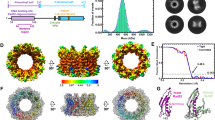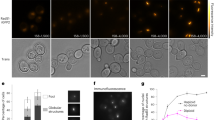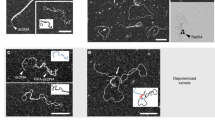Abstract
Homologous recombination is a conserved pathway for repairing double-stranded breaks, which are processed to yield single-stranded DNA overhangs that serve as platforms for presynaptic-complex assembly. Here we use single-molecule imaging to reveal the interplay between Saccharomyces cerevisiae RPA, Rad52 and Rad51 during presynaptic-complex assembly. We show that Rad52 binds RPA–ssDNA and suppresses RPA turnover, highlighting an unanticipated regulatory influence on protein dynamics. Rad51 binding extends the ssDNA, and Rad52–RPA clusters remain interspersed along the presynaptic complex. These clusters promote additional binding of RPA and Rad52. Our work illustrates the spatial and temporal progression of the association of RPA and Rad52 with the presynaptic complex and reveals a new RPA–Rad52–Rad51–ssDNA intermediate, with implications for how the activities of Rad52 and RPA are coordinated with Rad51 during the later stages of recombination.
This is a preview of subscription content, access via your institution
Access options
Subscribe to this journal
Receive 12 print issues and online access
$189.00 per year
only $15.75 per issue
Buy this article
- Purchase on Springer Link
- Instant access to full article PDF
Prices may be subject to local taxes which are calculated during checkout







Similar content being viewed by others
References
Mazon, G., Mimitou, E.P. & Symington, L.S. SnapShot: homologous recombination in DNA double-strand break repair. Cell 142, 646, 646.e1 (2010).
San Filippo, J., Sung, P. & Klein, H. Mechanism of eukaryotic homologous recombination. Annu. Rev. Biochem. 77, 229–257 (2008).
Krogh, B.O. & Symington, L.S. Recombination proteins in yeast. Annu. Rev. Genet. 38, 233–271 (2004).
Cromie, G.A., Connelly, J.C. & Leach, D.R. Recombination at double-strand breaks and DNA ends: conserved mechanisms from phage to humans. Mol. Cell 8, 1163–1174 (2001).
Cejka, P. et al. DNA end resection by Dna2–Sgs1–RPA and its stimulation by Top3–Rmi1 and Mre11–Rad50–Xrs2. Nature 467, 112–116 (2010).
Chen, X. et al. The Fun30 nucleosome remodeller promotes resection of DNA double-strand break ends. Nature 489, 576–580 (2012).
Mimitou, E.P. & Symington, L.S. Sae2, Exo1 and Sgs1 collaborate in DNA double-strand break processing. Nature 455, 770–774 (2008).
Niu, H. et al. Mechanism of the ATP-dependent DNA end-resection machinery from Saccharomyces cerevisiae. Nature 467, 108–111 (2010).
Zhu, Z., Chung, W.H., Shim, E.Y., Lee, S.E. & Ira, G. Sgs1 helicase and two nucleases Dna2 and Exo1 resect DNA double-strand break ends. Cell 134, 981–994 (2008).
Wold, M.S. Replication protein A: a heterotrimeric, single-stranded DNA-binding protein required for eukaryotic DNA metabolism. Annu. Rev. Biochem. 66, 61–92 (1997).
Broderick, S., Rehmet, K., Concannon, C. & Nasheuer, H.P. Eukaryotic single-stranded DNA binding proteins: central factors in genome stability. Subcell. Biochem. 50, 143–163 (2010).
Mimitou, E.P. & Symington, L.S. DNA end resection:unraveling the tail. DNA Repair (Amst.) 10, 344–348 (2011).
Lisby, M. & Rothstein, R. Choreography of recombination proteins during the DNA damage response. DNA Repair (Amst.) 8, 1068–1076 (2009).
Symington, L.S. & Gautier, J. Double-strand break end resection and repair pathway choice. Annu. Rev. Genet. 45, 247–271 (2011).
Choi, J.H. et al. Reconstitution of RPA-covered single-stranded DNA-activated ATR-Chk1 signaling. Proc. Natl. Acad. Sci. USA 107, 13660–13665 (2010).
Maréchal, A. et al. PRP19 Transforms into a sensor of RPA-ssDNA after DNA damage and drives ATR activation via a ubiquitin-mediated circuitry. Mol. Cell 53, 235–246 (2014).
Gasior, S.L., Wong, A.K., Kora, Y., Shinohara, A. & Bishop, D.K. Rad52 associates with RPA and functions with rad55 and rad57 to assemble meiotic recombination complexes. Genes Dev. 12, 2208–2221 (1998).
Hays, S.L., Firmenich, A.A., Massey, P., Banerjee, R. & Berg, P. Studies of the interaction between Rad52 protein and the yeast single-stranded DNA binding protein RPA. Mol. Cell. Biol. 18, 4400–4406 (1998).
Oakley, G.G. & Patrick, S.M. Replication protein A: directing traffic at the intersection of replication and repair. Front. Biosci. (Landmark Ed) 15, 883–900 (2010).
Plate, I. et al. Interaction with RPA is necessary for Rad52 repair center formation and for its mediator activity. J. Biol. Chem. 283, 29077–29085 (2008).
Conway, A.B. et al. Crystal structure of a Rad51 filament. Nat. Struct. Mol. Biol. 11, 791–796 (2004).
Ogawa, T., Yu, X., Shinohara, A. & Egelman, E.H. Similarity of the yeast RAD51 filament to the bacterial RecA filament. Science 259, 1896–1899 (1993).
Heyer, W.D., Ehmsen, K.T. & Liu, J. Regulation of homologous recombination in eukaryotes. Annu. Rev. Genet. 44, 113–139 (2010).
Symington, L.S. Role of RAD52 epistasis group genes in homologous recombination and double-strand break repair. Microbiol. Mol. Biol. Rev. 66, 630–670 (2002).
West, S.C. Molecular views of recombination proteins and their control. Nat. Rev. Mol. Cell Biol. 4, 435–445 (2003).
Bianco, P.R., Tracy, R.B. & Kowalczykowski, S.C. DNA strand exchange proteins: a biochemical and physical comparison. Front. Biosci. 3, D570–D603 (1998).
Sung, P. Function of yeast Rad52 protein as a mediator between replication protein A and the Rad51 recombinase. J. Biol. Chem. 272, 28194–28197 (1997).
Shinohara, A. & Ogawa, T. Stimulation by Rad52 of yeast Rad51-mediated recombination. Nature 391, 404–407 (1998).
New, J.H., Sugiyama, T., Zaitseva, E. & Kowalczykowski, S.C. Rad52 protein stimulates DNA strand exchange by Rad51 and replication protein A. Nature 391, 407–410 (1998).
Benson, F.E., Baumann, P. & West, S.C. Synergistic actions of Rad51 and Rad52 in recombination and DNA repair. Nature 391, 401–404 (1998).
Lao, J.P., Oh, S.D., Shinohara, M., Shinohara, A. & Hunter, N. Rad52 promotes postinvasion steps of meiotic double-strand-break repair. Mol. Cell 29, 517–524 (2008).
McIlwraith, M.J. & West, S.C. DNA repair synthesis facilitates RAD52-mediated second-end capture during DSB repair. Mol. Cell 29, 510–516 (2008).
Nimonkar, A.V., Sica, R.A. & Kowalczykowski, S.C. Rad52 promotes second-end DNA capture in double-stranded break repair to form complement-stabilized joint molecules. Proc. Natl. Acad. Sci. USA 106, 3077–3082 (2009).
Sugiyama, T., Kantake, N., Wu, Y. & Kowalczykowski, S.C. Rad52-mediated DNA annealing after Rad51-mediated DNA strand exchange promotes second ssDNA capture. EMBO J. 25, 5539–5548 (2006).
Lisby, M., Barlow, J.H., Burgess, R.C. & Rothstein, R. Choreography of the DNA damage response: spatiotemporal relationships among checkpoint and repair proteins. Cell 118, 699–713 (2004).
Lisby, M., Rothstein, R. & Mortensen, U.H. Rad52 forms DNA repair and recombination centers during S phase. Proc. Natl. Acad. Sci. USA 98, 8276–8282 (2001).
Feng, Z. et al. Rad52 inactivation is synthetically lethal with BRCA2 deficiency. Proc. Natl. Acad. Sci. USA 108, 686–691 (2011).
Jensen, R.B., Carreira, A. & Kowalczykowski, S.C. Purified human BRCA2 stimulates RAD51-mediated recombination. Nature 467, 678–683 (2010).
Gibb, B. et al. Concentration-dependent exchange of replication protein A on single-stranded DNA revealed by single-molecule imaging. PLoS ONE 9, e87922 (2014).
Deng, S.K., Gibb, B., de Almeida, M.J., Greene, E.C. & Symington, L.S. RPA antagonizes microhomology-mediated repair of DNA double-strand breaks. Nat. Struct. Mol. Biol. 21, 405–412 (2014).
Gibb, B., Silverstein, T.D., Finkelstein, I.J. & Greene, E.C. Single-stranded DNA curtains for real-time single-molecule visualization of protein-nucleic acid interactions. Anal. Chem. 84, 7607–7612 (2012).
Visnapuu, M.L., Fazio, T., Wind, S. & Greene, E.C. Parallel arrays of geometric nanowells for assembling curtains of DNA with controlled lateral dispersion. Langmuir 24, 11293–11299 (2008).
Sugiyama, T. & Kowalczykowski, S.C. Rad52 protein associates with replication protein A (RPA)-single-stranded DNA to accelerate Rad51-mediated displacement of RPA and presynaptic complex formation. J. Biol. Chem. 277, 31663–31672 (2002).
Sugiyama, T. & Kantake, N. Dynamic regulatory interactions of Rad51, Rad52, and replication protein-A in recombination intermediates. J. Mol. Biol. 390, 45–55 (2009).
Sugiyama, T., New, J.H. & Kowalczykowski, S.C. DNA annealing by RAD52 protein is stimulated by specific interaction with the complex of replication protein A and single-stranded DNA. Proc. Natl. Acad. Sci. USA 95, 6049–6054 (1998).
Shinohara, A., Shinohara, M., Ohta, T., Matsuda, S. & Ogawa, T. Rad52 forms ring structures and co-operates with RPA in single-strand DNA annealing. Genes Cells 3, 145–156 (1998).
Singleton, M.R., Wentzell, L.M., Liu, Y., West, S.C. & Wigley, D.B. Structure of the single-strand annealing domain of human RAD52 protein. Proc. Natl. Acad. Sci. USA 99, 13492–13497 (2002).
Stasiak, A.Z. et al. The human Rad52 protein exists as a heptameric ring. Curr. Biol. 10, 337–340 (2000).
Graham, J.S., Johnson, R.C. & Marko, J.F. Concentration-dependent exchange accelerates turnover of proteins bound to double-stranded DNA. Nucleic Acids Res. 39, 2249–2259 (2011).
Sing, C.E., Olvera de la Cruz, M. & Marko, J.F. Multiple-binding-site mechanism explains concentration-dependent unbinding rates of DNA-binding proteins. Nucleic Acids Res. 42, 3783–3791 (2014).
Sung, P. & Klein, H. Mechanism of homologous recombination: mediators and helicases take on regulatory functions. Nat. Rev. Mol. Cell Biol. 7, 739–750 (2006).
Wang, X. & Haber, J.E. Role of Saccharomyces single-stranded DNA-binding protein RPA in the strand invasion step of double-strand break repair. PLoS Biol. 2, E21 (2004).
Miyazaki, T., Bressan, D.A., Shinohara, M., Haber, J.E. & Shinohara, A. In vivo assembly and disassembly of Rad51 and Rad52 complexes during double-strand break repair. EMBO J. 23, 939–949 (2004).
Miné-Hattab, J. & Rothstein, R. Increased chromosome mobility facilitates homology search during recombination. Nat. Cell Biol. 14, 510–517 (2012).
Efron, B. & Tibshirani, R. An Introduction to the Bootstrap (Champman and Hall, New York, 1993).
Antúnez de Mayolo, A. et al. Multiple start codons and phosphorylation result in discrete Rad52 protein species. Nucleic Acids Res. 34, 2587–2597 (2006).
Galletto, R., Amitani, I., Baskin, R.J. & Kowalczykowski, S.C. Direct observation of individual RecA filaments assembling on single DNA molecules. Nature 443, 875–878 (2006).
Krejci, L. et al. Interaction with Rad51 is indispensable for recombination mediator function of Rad52. J. Biol. Chem. 277, 40132–40141 (2002).
Busygina, V. et al. Hed1 regulates Rad51-mediated recombination via a novel mechanism. Genes Dev. 22, 786–795 (2008).
Kwon, Y., Zhao, W. & Sung, P. Biochemical studies on human Rad51-mediated homologous recombination. Methods Mol. Biol. 745, 421–435 (2011).
Greene, E.C., Wind, S., Fazio, T., Gorman, J. & Visnapuu, M.L. DNA curtains for high-throughput single-molecule optical imaging. Methods Enzymol. 472, 293–315 (2010).
Acknowledgements
We thank L. Symington and members of the Greene and Sung laboratories for comments on the manuscript. This research was funded by the US National Institutes of Health grants GM074739 (E.C.G), RO1ES007061 (P.S.) and CA146940 (E.C.G. and P.S.). This work was partially supported by the Nanoscale Science and Engineering Initiative of the US National Science Foundation under award no. CHE-0641523 and by the New York State Office of Science, Technology, and Academic Research (NYSTAR). E.C.G. is supported as an Early Career Scientist by the Howard Hughes Medical Institute.
Author information
Authors and Affiliations
Contributions
B.G. and L.F.Y. cloned, expressed and purified RPA and Rad52, conducted the single-molecule experiments and analyzed the resulting data. Y.K. and H.N. expressed and purified Rad51, and Y.K. conducted bulk biochemical experiments. E.C.G. supervised the project. B.G. and E.C.G. wrote the manuscript with input from all coauthors.
Corresponding author
Ethics declarations
Competing interests
The authors declare no competing financial interests.
Integrated supplementary information
Supplementary Figure 1 Strand-annealing activity assays for fluorescent versions of Rad52.
(a) Schematic of strand annealing assay using complementary 83-nt ssDNA substrates, one of which was radiolabeled (red asterisk). Each substrate was mixed with RPA followed by Rad52, and the two reaction mixes were combined and incubated for the indicated times. (b) Products were resolved by 8% PAGE and (c) quantitated by phosphorimaging (error bars report the standard deviation of 3 experiments).
Supplementary Figure 2 Mediator activity assays for fluorescent versions of Rad52.
(a) Schematic for the mediator assay using a 150-nt ssDNA substrate that was mixed with RPA, Rad52, and Rad52, followed by the addition of a radiolabeled 40-bp dsDNA substrate. (b) Reactions were incubated for an additional 30 minutes, and reaction products were resolved by 8% PAGE and (c) quantitated by phosphorimaging (error bars report the standard deviation of 2-4 experiments). For quantitation, the amount of product formed in the presence of only Rad51 and RPA (lane 3), was subtracted from the amount of product formed in reactions with Rad52.
Supplementary Figure 3 Rad52 does not displace RPA from ssDNA.
A biotinylated 74-nt ssDNA oligo was bound to streptavidin magnetic beads and incubated with saturating amounts of wt RPA (400 nM). Increasing amounts of wt Rad52 were then added to the RPA-bound oligo in the presence of 400 nM free RPA and incubated for 20 minutes at 30 °C. The bound and free fractions were separated by pelleting the beads, and then resolved on an 8-16% SDS-PAGE gel and detected with Coomassie staining. Note that Rfa3 migrates off the gels under these electrophoresis conditions.
Supplementary Figure 4 Rad52 binding to sites occupied by preexisting Rad52 complexes.
(a) Positions of SNAP488-Rad52 (green) bound to a wtRPA-ssDNA complex. (b) Kymograph showing SNAP546-Rad52 (magenta) association with the SNAP488-Rad52/wtRPA/ssDNA complexes. (c) Line graphs showing integrated intensities of SNAP488-Rad52 and average integrated intensity over time for SNAP546-Rad52. The pixel positions for all three panels are co-aligned for direct comparison. (d-f) Same sets of data collected from a different ssDNA molecule.
Supplementary Figure 5 RPA-mCherry bound by wild-type Rad52 resists exchange when chased with wild-type RPA.
(a) Additional examples of kymographs showing RPA-mCherry turnover in the presence of wt RPA. (b) Examples of kymographs showing that the presence of wt Rad52 (0.6 − 1.0 nM) suppresses RPA-mCherry turnover when chased with wt RPA. (c) Examples of integrated RPA-mCherry signal over time (± 0.6 - 1.0 nM Rad52) after chasing with 100 nM wt RPA. The slower decrease in signal observed after the initial phase of rapid turnover is attributed to photo-bleaching.
Supplementary Figure 6 Co-occupancy of RPA, Rad52 and RPA on ssDNA.
Pull down assays performed with (a) ssDNA cellulose and (b) a 74-nt biotinylated oligo bound to streptavidin magnetic beads. The ssDNA was mixed buffer containing wt Rad51 (10 μM), wt Rad52 (1 μM), and wt RPA (0, 25, 50, 100, 200, and 400 nM) for 10 minutes at 37°C. Free and bound fractions were recovered and then resolved on an 8-16% SDS-PAGE gel and detected with Coomassie staining. A beads only negative control (labeled Beads or Beads NC) in (b) shows little protein binding to magnetic beads lacking ssDNA.
Supplementary information
Supplementary Text and Figures
Supplementary Figures 1–6 (PDF 1615 kb)
Rights and permissions
About this article
Cite this article
Gibb, B., Ye, L., Kwon, Y. et al. Protein dynamics during presynaptic-complex assembly on individual single-stranded DNA molecules. Nat Struct Mol Biol 21, 893–900 (2014). https://doi.org/10.1038/nsmb.2886
Received:
Accepted:
Published:
Issue Date:
DOI: https://doi.org/10.1038/nsmb.2886
This article is cited by
-
HELQ is a dual-function DSB repair enzyme modulated by RPA and RAD51
Nature (2022)
-
New insights into the mechanism of RPA in preserving genome stability
Genome Instability & Disease (2022)
-
Exploiting synthetic lethality to target BRCA1/2-deficient tumors: where we stand
Oncogene (2021)
-
Emerging non-canonical roles for the Rad51–Rad52 interaction in response to double-strand breaks in yeast
Current Genetics (2020)
-
Dynamics and selective remodeling of the DNA-binding domains of RPA
Nature Structural & Molecular Biology (2019)



